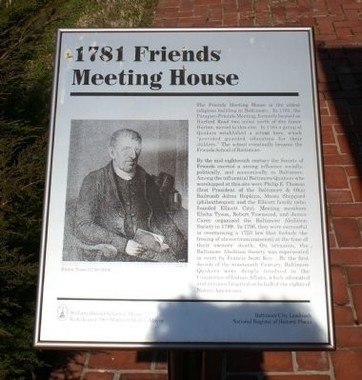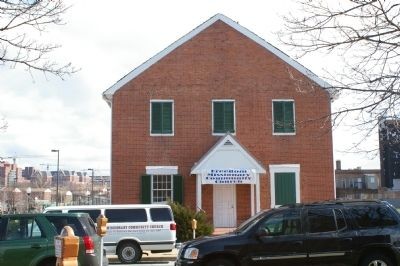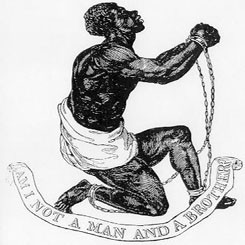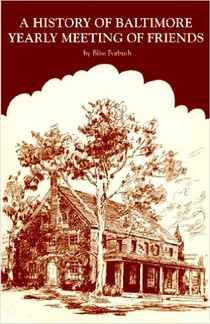1781 Old Town Friends Meeting House
Introduction
Text-to-speech Audio
Images
Friends Meeting Place historical marker

Friends Meeting Place building

Quaker anti-slavery cartoon

Book about Baltimore Quaker history

Backstory and Context
Text-to-speech Audio
Architecturally, the Patapsco Meeting's new house was a two story building featuring separate entrances for men and women which opened up into a large meeting room which could be sectioned off with sliding wood doors to give men and women their own meeting spaces. The design is attributed to George Matthews.
Quakers held a great deal of social, economic, and political influence in Baltimore by the mid-eighteenth century. Important eighteenth and nineteenth century Baltimore area Quakers included Johns Hopkins, Philip E. Thomas (the first Baltimore and Ohio Railroad president), Moses Sheppard (philanthropist), and the Elicott family (founders of Elicott City). A large aspect of Quakerism historically is working towards social reform, such as the abolition of slavery and prison reform.
In 1789, Friends Meeting members Elisha Tyson, Robert Townsend, and James Carey founded the Baltimore Abolition Society. This group overturned a 1753 law that bound people to slavery even after their owner’s death. Francis Scott Key, who wrote the “Star Spangled Banner,” represented the Baltimore Abolition Society in court on multiple occasions. Baltimore Quakers also advocated for the rights of Native Americans by becoming involved with the Committee of Indian Affairs.
Eighteenth and nineteenth century Quakers who were opposed to slavery were aware that Quakers had, in the past, held slaves. However by this time, the practice had been deemed immoral within the Quaker belief system. Jonathan Dymond, an English Quaker, said, “[A]ny human being who has not forfeited his liberty by his crimes, has a right to be free—and that whosoever forcibly withhold liberty from an innocent man robs him of his rights and violates the moral law.” Another Quaker, William Jackson of Pennsylvania, wrote in an 1846 pamphlet, “No one is under any moral obligation to lend himself as a tool to others for the commission of a crime, even when commanded by his government to do the wrong.”
Cite This Entry
Lenox, Laney and Daphne Fruchtman. "1781 Old Town Friends Meeting House." Clio: Your Guide to History. February 11, 2017. Accessed August 14, 2025. https://theclio.com/entry/20345
Sources
"1781 Friends Meeting House," The Historical Marker Database, http://www.hmdb.org/marker.asp?marker=6282
"Quakers in Action," Quakers in the World, http://www.quakersintheworld.org/quakers-in-action/207
"Old Town Friends' Meeting House," The Baltimore Sun, http://www.baltimoresun.com/news/maryland/bal-md-city-landmarks-ds20120917112104-photo.html
The McKim Community Association, "Aisquith Street Meeting House," Baltimore Heritage, https://explore.baltimoreheritage.org/items/show/203#.WJ-hmDfC6sM
"Old Town Friend's Meetinghouse and McKim's School," National Park Service, https://www.nps.gov/nr/travel/baltimore/b31.htm

